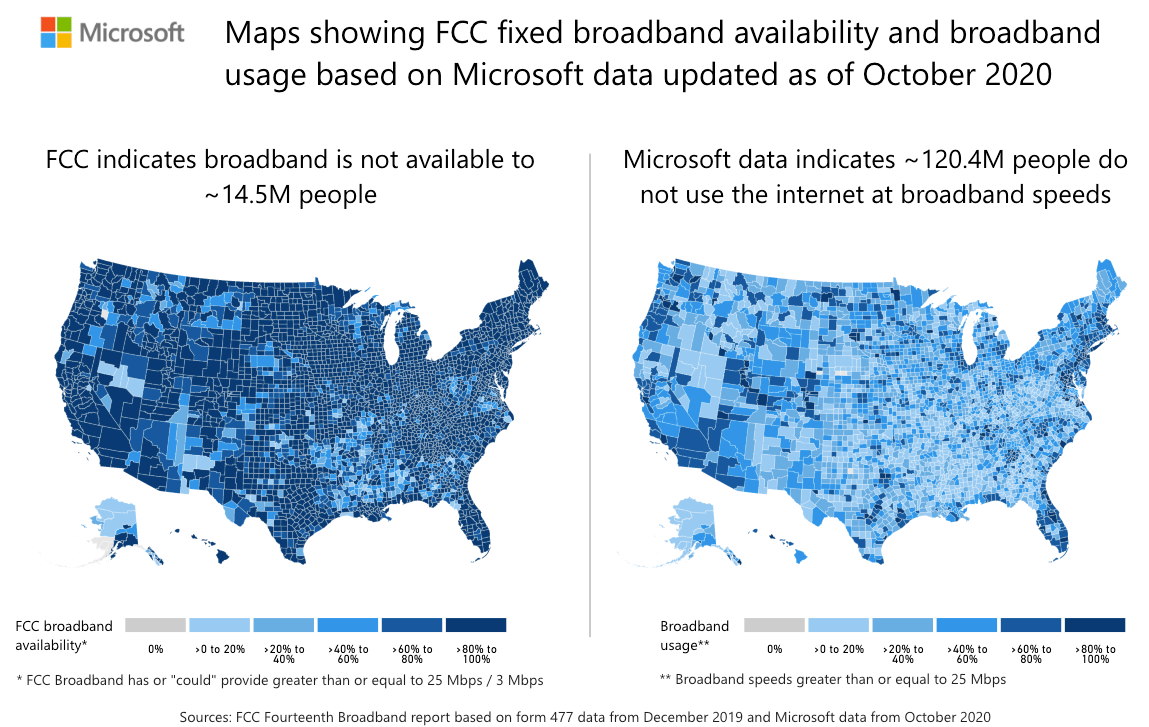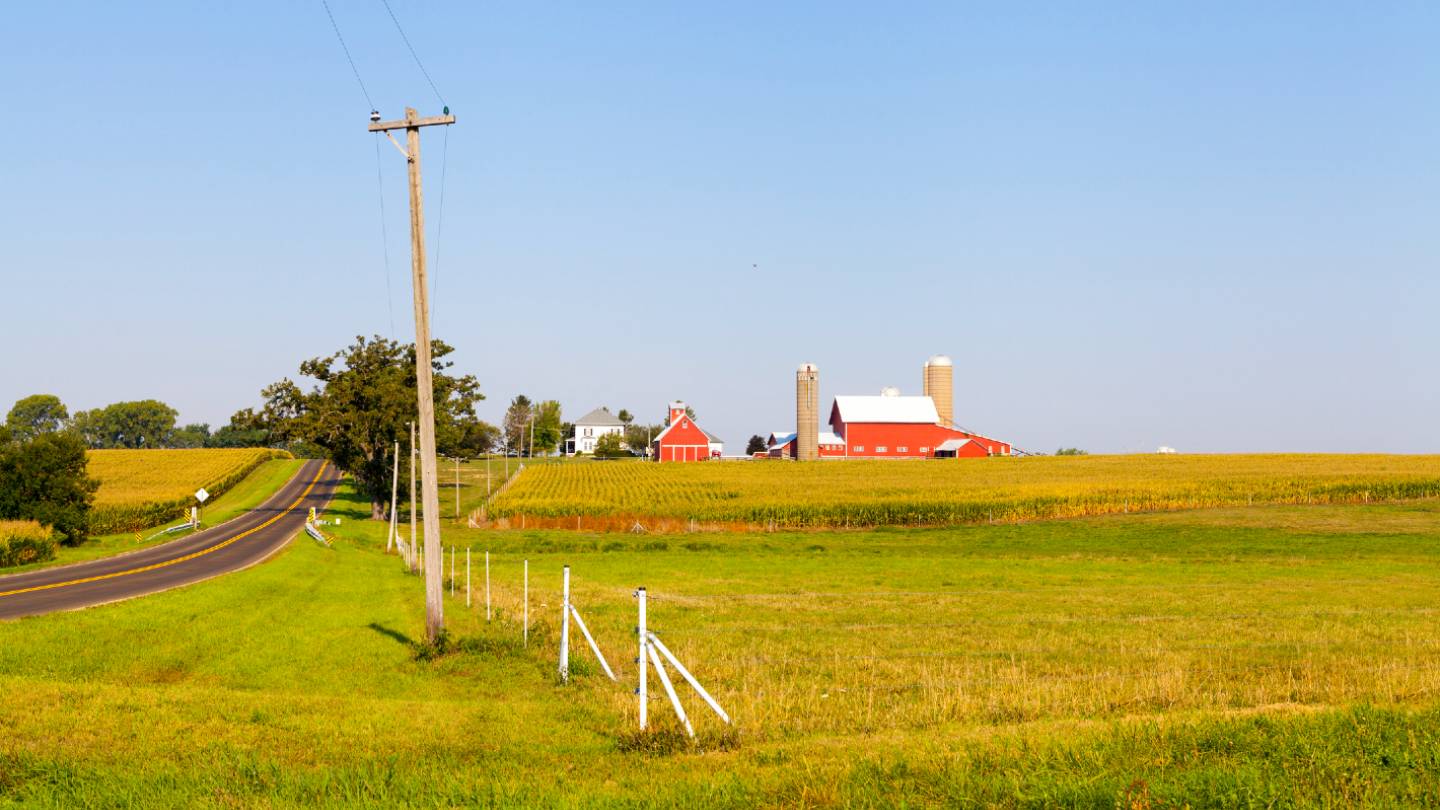Rural broadband access in the U.S. has improved in recent years, but there’s still a long way to go to ensure all rural residents have access to high-speed internet.
Four of five counties with the lowest levels of broadband access in the U.S. — below 40% — are in the country’s most rural areas. This tells us that while rural areas have seen an increase in broadband access in the last decade, they still fall behind suburban and urban communities.

Current state of rural broadband
Rural broadband access is definitely in a better place than it was a few years ago. Rural broadband adoption has increased 9% since 2016 and about 63% of rural residents report having a high-speed internet connection at home.
In its 2022 survey, the Rural Broadband Association reported that nearly 82% of respondents’ customers on average could receive download speeds greater than or equal to 100 Mbps, which is an almost 7% increase since 2021.
The survey also found that 61% of customers have access to gigabit speeds, another improvement from the previous year’s 55%.
Fiber to the home technology (FTTH) has become more accessible in these areas as well, enabling rural communities to sign up for higher speeds as they become available.
The survey reports that almost 50% of respondents’ rural customers subscribe to 100 Mbps or greater and 37% sign up for speeds between 100 Mbps and 1 Gbps.
This is an impressive improvement from previous years when rural areas were lucky to surpass the FCC’s minimum broadband speed standard of 25 Mbps. Nevertheless, there are still about 42 million Americans without internet access, and many live in low-income, rural regions.
Lack of broadband adoption
Rural residents are online less frequently than urban and suburban residents, and they are less likely to own multiple devices requiring an internet connection.
Only 3 in 10 rural residents report having a broadband connection while owning a laptop or desktop, smartphone and tablet compared to 44% of urban residents.

While these behaviors could be attributed to a typical rural lifestyle, a lack of consistent and reliable internet connection could also determine rural residents’ internet habits.
Why is there less broadband access in rural areas?
Housing in low-income, rural areas is more spaced out than condensed housing in urban and suburban areas.
Internet service providers are incentivized to build out broadband infrastructure in more densely populated areas because more people subscribe to their services in these regions.
Inaccurate broadband data
Broadband data inaccuracies contributed to a lack of funding for rural broadband access.
In recent years, the Federal Communications Commission’s (FCC) broadband data maps were under scrutiny for incorrectly reporting the number of Americans without broadband access. The number was much higher than what the FCC estimated.

Some areas of the country are listed as having broadband access when they actually do not, making it harder for that area to receive the funding dollars it needs.
The FCC has since begun the process of gathering new, more accurate data to create improved broadband maps.
Recent steps to improve rural broadband access
Infrastructure Investment Bill and American Jobs Act
The Bipartisan Infrastructure Law was passed in 2021 and will deliver $65 billion in funding to build out broadband infrastructure in unserved and underserved areas.
The funding is being provided through the National Telecommunications and Information Administration (NTIA). The NTIA is in the process of administering grants through its “Internet for All” initiative, which includes various programs like BEAD and the Digital Equity Act programs.
Broadband Equity, Access and Deployment Program
The Broadband Equity, Access and Deployment program (BEAD) provides $42.45 billion in state broadband grants to expand high-speed internet access by funding planning, infrastructure deployment and adoption programs in all 50 states and the U.S. territories.
The program is well underway and the NTIA has already allocated millions in planning funds to various states. The NTIA plans to release the bulk of funding for the program by June 30, 2023 — but in the meantime, U.S. states and territories are submitting proposals for NTIA approval.
Broadband Data Collection Program
An integral part of the broadband infrastructure deployment initiatives is the Broadband Data Collection Program (BDC). The BDC program aims to provide accurate data on where broadband service is available and where it is not.
The FCC launched the BDC program with a new system for gathering broadband availability data to rectify the data inaccuracies in the previous data maps we mentioned above.
The first drafts of the maps were released in the fall of 2022 and will be important in determining the direction of the upcoming broadband infrastructure funding.
ReConnect Program
The ReConnect Program provides loans and grants for the construction cost and improvement of broadband service in rural areas. The program has already gone through two funding rounds with almost $800 million announced for the third funding round.
Affordable Connectivity Program
The Affordable Connectivity Program (ACP) is a federal program that provides eligible households with a $30/mo. stipend for their internet plan. Those on qualifying tribal lands can get up to $75/mo.
The bottom line
Increasing rural broadband access in America has been a slow journey, but many programs and initiatives are underway.
While it will be some time before every rural area in the U.S. can use high-speed internet, the millions in broadband funding dollars and rise in fiber-optic networks in rural areas hint at a positive future.
If you’re looking to switch providers or find the best provider for rural internet access, check out our best rural internet providers guide.
Methodology
The data in this article has been pulled from noteworthy sources like the Pew Research Center, Public Reference Bureau and the Rural Broadband Association.
We researched studies and surveys including a 2021 Pew Research Center study about the digital divide, a PRB article about the counties with the least broadband access and a Rural Broadband Association study about rural broadband speed tiers. We also sourced information from federal program websites and publications like Pew Charitable Trusts.
Allconnect: Let us compare providers for you
Why should you choose Allconnect? We’re the #1 broadband marketplace in the U.S, meaning you can trust us to search, compare and order internet and TV service for your home.
Get started

Written by:
Camryn Smith
Cammy is a writer with Allconnect, growing her broadband industry knowledge for over a year on the internet marketplace. Her expertise lies in home internet and broadband service with a focus on providers, plans…
Read more
Edited by:
Robin LaytonEditor, Broadband Content
-
Featured
![Business vs. residential internet: Which is better for you?]() Business vs. residential internet: Which is better for you? Camryn Smith — 4 min read
Business vs. residential internet: Which is better for you? Camryn Smith — 4 min read -
Featured
![7 tips to reduce lag when online gaming]() 7 tips to reduce lag when online gaming Ari Howard — 4 min read
7 tips to reduce lag when online gaming Ari Howard — 4 min read -
Featured
![New FCC broadband maps are here, promising a better picture of your internet options]() New FCC broadband maps are here, promising a better picture of your internet options Robin Layton — 3 min read
New FCC broadband maps are here, promising a better picture of your internet options Robin Layton — 3 min read
Latest
-
Thursday, July 25, 2024
Worried about losing your signal? This is how to keep your satellite dish cleanDavid Anders — 6 min read
-
Tuesday, July 23, 2024
The best free TV and movie streaming services 2024Camryn Smith — 5 min read
-
Tuesday, July 23, 2024
Everything you need to know about internet speedsRobin Layton — 8 min read






